Summary

Map of Cuba
Cuba, the largest island in the Caribbean Sea, is a unitary republic with a one-party dictatorship. Cuba has been ranked “not free” in all of Freedom House’s world surveys since 1973, among or near the ten worst-ranked countries.
Prior to Christopher Columbus’s landing in 1492, Cuba’s main inhabitants were the Taino nation. Due to disease and forced labor, most indigenous people did not survive Spanish colonization. For most of the next 400 years, the island’s economy relied on enslaved persons taken by force from Africa (Cuba was the last country in the Hemisphere to abolish slavery in 1886).
Cuba was among the few territories held as colonies by Spain after the Wars of Independence in South America. Cuba was ceded to the United States in 1898 at the end of the Spanish-American War, which was undertaken by the U.S. in part to support Cuba's independence movement. Independence was declared in 1902 and granted by the U.S. conditionally under the Platt Amendment. Thereafter, Cuba alternated between democratic and authoritarian regimes.
In 1959, the authoritarian rule of Fulgencio Batista was overthrown by the July 26 Movement led by Fidel Castro. In consolidating power, Castro acted swiftly to establish a one-party communist dictatorship and allied with the Soviet Union. Despite the loss of large subsidies after the Soviet Union’s collapse in 1991, Cuba remained politically unchanged. Reforms have allowed some private economic activities and property ownership, but the state still controls most economic activity. The regime harshly represses any political or social opposition, most recently the July 11 protest movement in 2021.
Cuba’s current population of 11.2 million is 64 percent white, 27 percent mestizo (mixed race), and 9 percent Afro-Cuban. Since 1959, 1.3 million Cubans have left the island for political and economic reasons. Most have gone to the United States. The International Monetary Fund no longer estimates Cuba’s GDP. The World Bank estimated Cuba’s nominal GDP in 2021 at $107 billion (68th in the world) with per capita income at $8,800 per annum (78th). These measures, however, do not reflect Cuba’s high levels of income inequality.
History
Cuba was inhabited starting in the fourth millennium BCE. The Taino indigenous nation arrived in the third century CE and were the island’s main population when Christopher Columbus’s ships landed in 1492 and claimed the territory for the united Spanish Kingdom of Aragon and Castille.
Spain established its first permanent settlement in Cuba in 1511. From that time, Cuba was under Spanish colonial rule until 1898 (except for 1762–63, when the British occupied the island during the Seven Years’ War).
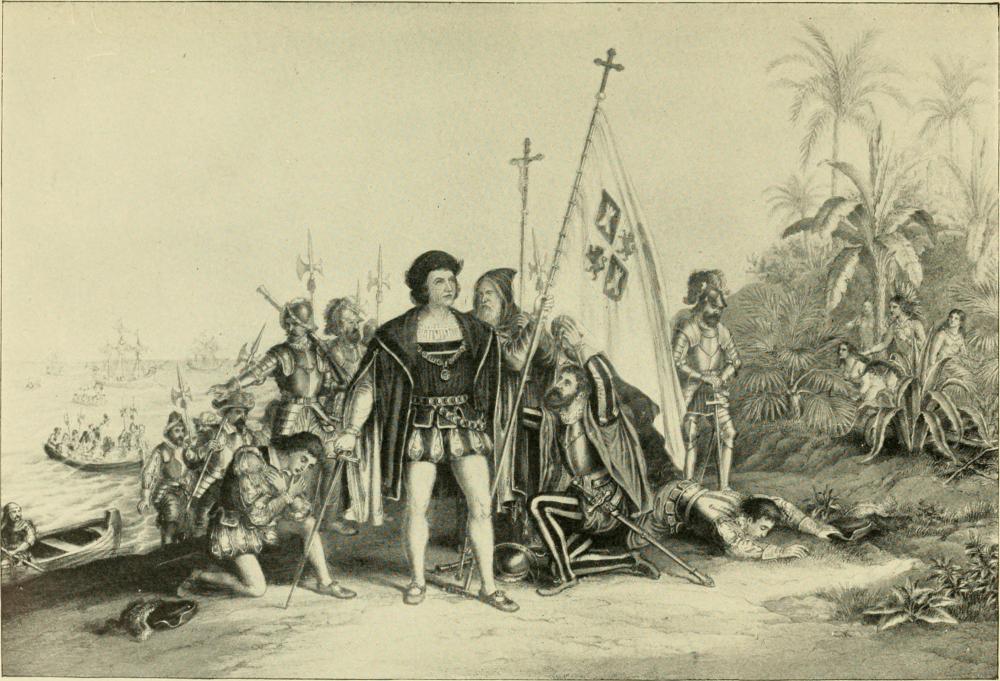
A depiction of the landing of Christopher Columbus in 1492. Columbus claimed the island for the Spanish Kingdom of Aragon and Castille. Spanish colonization led to the destruction of the indigenous Taino and to a slave economy, which lasted for much of the next 400 years. Public Domain. Library of Congress.
From the mid-1500s on, as the Taino population declined, Spanish colonists forcibly brought Africans for enslavement, mostly to carry out agricultural labor ─ around 1 million persons total.
The indigenous peoples on the island (estimates range from 16,000 to 200,000) were decimated by disease, dislocation and enslavement, but some Taino and Guanahatbey inter-mixed with Spanish colonists to form a mestizo (mixed race) community. From the mid-1500s on, as the Taino population declined, Spanish colonists forcibly brought Africans for enslavement, mostly to carry out agricultural labor ─ around 1 million persons total.
Slavery expanded especially in the 18th century with the increased cultivation of sugar cane. Aided by French colonists who fled the successful revolts of enslaved persons in Haiti, Cuba supplanted Haiti as the world's largest sugar producer in addition to becoming a major exporter of tobacco and coffee.
Abolition of Slavery and Independence
Cuba was among the few Spanish-held territories in the Western Hemisphere that did not gain independence in the aftermath of the Napoleonic Wars in the early-to-mid 18th century. An effort to achieve independence began in 1868 when Carlos Manuel de Cespedes and some other landowners freed their slaves and organized an armed rebellion. Their ten-year armed struggle to establish a republic failed, but the conflict led the Spanish king to formally abolish slavery in Cuba in 1886 ─ the last territory in the hemisphere to do so.
Cuba was among the few Spanish-held territories in the Western Hemisphere that did not gain independence in the aftermath of the Napoleonic Wars in the early-to-mid 18th century. An effort to achieve independence began in 1868
In 1895, Jose Marti, whose writings in support of freedom made him a symbol of the Cuban independence struggle, led fellow exiles in an armed attack to end Spanish rule on the island. He died a month after the exiles’ landing, but the uprising continued and gained strength in the countryside.
Even so, the rebel forces failed to take any major cities until the United States intervened in 1898 in support of Cuban independence as part of the Spanish-American War. US armed forces won quick military victories and Spain ceded to the United States control over its remaining colonies — Cuba, Puerto Rico, Guam and the Philippines —in the Treaty of Paris. Cuba gained independence from Spain, but as a protectorate under US occupation in a period when the United States openly sought empire.
Independence and the Platt Amendment

Cuba achieved independence in May 1902, with conditional approval by the United States. Tomas Estrada Palma, above, was elected the first president. Violence following his second election in 1905 forced his resignation. Public Domain.
A Constituent Assembly adopted a constitution and independence was fully achieved in May 1902 as US authorities formally ceded power to a newly elected president, Tomas Estrada Palma. The constitution, modeled on that of the United States, established a presidential system.
As part of the agreed handover of power, the US Congress adopted the Platt Amendment, which guaranteed Cuban independence but required Cuba to lease Guantanamo Bay to the United States on an open-ended basis and granted the US the power to intervene in Cuban affairs as protector of its independence. (The Platt Amendment was incorporated into the new republic's constitution.) US forces reoccupied the country from 1906 to 1909 in order to put down a rebellion. Even after returning control to Cuban leaders, the US remained highly involved in Cuba and US investors dominated many aspects of the island's economy, including sugar production, industry and tourism. The United States would intervene militarily two additional times.
Democracy and Dictatorship
From 1902, Cuba had a fitful electoral democracy with competing political parties and competitive elections but not fully free conditions. (For example, one Afro-Cuban party was fully banned in 1912.)
From 1902, Cuba had a fitful electoral democracy with competing political parties and competitive elections but not fully free conditions.
In 1933, the “Sergeant’s Revolt” overthrew an increasingly dictatorial Gerardo Machado, who was first elected president in 1924 but refused to leave office after a second term. A provisional government abrogated the Platt Agreement and initiated reforms to reduce the power of the post-colonial oligarchy.
This time the U.S. did not intervene militarily, but it did back a coup led by Fulgencio Batista, another army sergeant, to assert political control over the island. Batista declared himself army chief of staff to wield power behind the scenes before running for president himself in 1940.

Fulgencio Batista (shown in 1938) organized a coup in 1933 and exerted control as army chief of staff. Elected in 1940 to serve one term as president under a revised constitution, he went into exile but returned to Cuba in 1952 and seized power in another coup. Public Domain.
The election was under a new constitution that reflected some of the reform elements of the original “Sergeant’s Revolt,” such as limiting the presidency to one term. Batista pledged pro-worker policies to gain support from a radical labor movement and won the election. Not allowed to run again, he retired to the United States in 1944. Subsequent presidents continued reformist policies.
Batista returned to Cuba to run for president again in 1952. Failing to gain public support, he seized power in a bloodless coup three months prior to the election. He suspended the 1940 constitution and held elections in 1953 under controlled conditions, winning the presidency despite strong opposition to his political manipulation. Batista increasingly adopted authoritarian-style rule.
The Overthrow of Batista
When a young lawyer and radical activist, Fidel Castro, failed to win a seat for a radical party in legislative elections, he decided to organize an armed guerilla attack on the main army barracks on July 26, 1953. The attack failed in dramatic fashion. After being jailed for two years, he was sent into exile in Mexico. He returned in December 1956 with another small rebel force called the July 26 Movement.
Facing military defections and civilian resistance in the cities, Batista fled on January 1, 1959. Castro asserted control with his July 26 Movement guerrilla force to form a provisional government.
The group's landing was also a failure, but this time Castro escaped to the Sierra Maestra highlands with several other revolutionaries. He recruited new guerrilla fighters and allied with other anti-Batista groups to build support. By late 1958, a coalition of armed forces gained ground as Batista lost support both internally and in the United States. Facing military defections and civilian resistance in the cities, Batista fled on January 1, 1959. Castro asserted control with his July 26 Movement guerrilla force to form a provisional government.
Consolidation of Power
Castro consolidated personal power quickly and established a communist dictatorship. Non-communist leaders of the revolution, such as Huber Matos, were imprisoned or worse. A close ally, Che Guevara, was put in charge of tribunals set up against “enemies of the revolution.” An estimated 4,000 people were murdered. Media and other institutions were closed or taken over. Revolutionary Neighborhood Committees (CDRs) spied on the citizenry and reported on any opponents of the regime to the security police.

Fidel Castro, shown here in trademark fatigues in the late 1950s, organized an armed revolutionary movement called the July 26 movement. Castro asserted control, establishing a one-party communist dictatorship. He ruled Cuba for 47 years. Public Domain.
In early 1960, Castro signed a trade agreement with the Soviet Union and seized facilities of US oil companies that refused to process Soviet crude oil. After further expropriation of US and other foreign assets, the United States imposed a trade embargo on exports to Cuba and broke off diplomatic relations in October. In April 1961, an armed force of 1,400 Cuban exiles, sponsored and trained by the CIA, landed at the Bay of Pigs on Cuba's southern coast to foment an uprising and overthrow the regime. The attempt was quickly suppressed. Participants were killed or imprisoned.
By the end of 1961, Castro had nationalized most property, ordered the collectivization of agriculture and publicly defined himself, and the Revolution, as communist in alignment with the Soviet Union. The trade union federation was taken over and made into a monolithic structure to control the workforce. Castro repressed the Roman Catholic Church by taking over religious schools and imprisoning or expelling clergy members. Harsh measures were adopted for all “deviant” behavior, resulting in widespread repression of homosexuals.
The 1962 Missile Crisis and the Embargo
By the end of 1961, Castro had nationalized most property, ordered the collectivization of agriculture and publicly defined himself, and the Revolution, as communist in alignment with the Soviet Union.
In October 1962, the US government confirmed that the Soviet Union was establishing intermediate-range nuclear missile bases in Cuba. President John Kennedy ordered a naval blockade to prevent the transfer of missiles to the island. After a tense standoff with Soviet vessels that included threats to use nuclear weapons, Soviet leader Nikita Khrushchev agreed to withdraw the weapons and dismantle the bases in exchange for a US pledge not to invade Cuba in the future and agreement to remove nuclear missiles from Turkey. While the United States government pledged not to invade, it still considered the Cuban regime’s alignment with the USSR a security threat and maintained a full trade embargo. The embargo remained in place as Cuba supported armed revolutionary movements and terrorist organizations in Latin America and Africa being backed by the Soviet Union.
The Exodus
After an initial exodus of 200,000 people following the Cuban Revolution, the government required exit visas to leave the country. In 1965, Fidel Castro agreed to allow the United States to provide air transport for people seeking to leave. Around 250,000 more Cubans emigrated between 1965 and 1973.

Altogether, since 1959, an estimated 1.3 million Cubans have fled the island due to repression and poor economic conditions. Above, a group of the 125,000 refugees who left Cuba during the Mariel Boatlift in 1980, when Fidel Castro briefly allowed boat crossings. Public Domain. Department of Homeland Security.
In 1980, when Castro briefly relaxed exit requirements, 125,000 people fled Cuba in the so-called Mariel Boatlift. Castro used the boatlift to expel violent criminals and psychiatric patients in violation of humanitarian law.
A surge in attempts by Cubans to reach the United States on flimsy rafts in the early 1990s led to a US-Cuban agreement in 1994 allowing 20,000 people a year to emigrate through normal channels but obliged the U.S. to return refugees caught at sea making an illegal crossing. Cubans who set foot on US shores were granted asylum. After the Obama Administration normalized relations with Cuba in 2016 (see below), the “dry land” policy was ended but emigration has continued. Since 2021, with economic conditions declining due to the Covid 19-pandemic, 250,000 more have fled, many to the U.S.
Altogether since 1959, an estimated 1.3 million Cubans have fled the island.
Economic Freedom
Under Spanish colonial rule, Cuba had a slave economy from the 16th to the 19th centuries, enslaving first the indigenous Taino and Guanahatabey peoples and then forcibly bringing an estimated 1 million Africans for enslaved labor to work mostly on sugar plantations. Many others died on the Middle Passage voyage.
The colonial regime developed an oligarchic society that exercised power over the remaining white, mestizo and free Black population, with limited economic freedoms that expanded only slowly over the 18th and 19th centuries as slavery began to decline. Following a Cuban revolt to gain independence and US intervention on its behalf, Cuba was ceded to the United States in 1898 in the Treaty of Paris to end the Spanish-American War and the 400-year period of Spanish colonial rule.
Full independence was established in 1902 with the withdrawal of US occupation forces, but Cuba’s politics and economy were highly impacted by three subsequent US military occupations and by US economic interests.
Full independence was established in 1902 with the withdrawal of US occupation forces, but Cuba’s politics and economy were highly impacted by three subsequent US military occupations and by US economic interests. Several governments under a revised 1940 Constitution established greater economic freedom both in the protection of property rights and in adoption of policies reducing worker exploitation. In the 1950s, Cuba ranked 7th in nominal GDP and relatively high in GDP per capita among 47 Latin America and Caribbean economies. But poverty remained widespread.
Following the 1959 Cuban Revolution led by Fidel Castro, the island has been ruled as a communist dictatorship and Cuba was formally allied with the Soviet Union until its collapse in 1991. The Communist Party of Cuba (PCC) controls political, military and security structures of the state as well as social and economic institutions, including regime-controlled trade unions. Imprisonment, torture, forced labor and neighborhood surveillance are commonly used to limit opposition or dissent.
The Communist Party of Cuba (PCC) controls political, military and security structures of the state as well as social and economic institutions, including regime-controlled trade unions.
Until 1994, private economic activity was limited except as organized illegally in a black market. Foreign companies were nationalized, private property seized and agriculture collectivized. The state directed economic activity, including production, distribution and setting prices for goods and services.
Supporters point to economic and social rights like a nationalized health service and universal education as achievements of the Cuban Revolution, but there is generalized poverty, which is extreme for Afro-Cuban and other marginalized communities. Medical services are poor except as provided for the communist party-state hierarchy. Schools have shortages of teachers and schoolbooks. Food rationing, introduced in 1962, continues to the present.
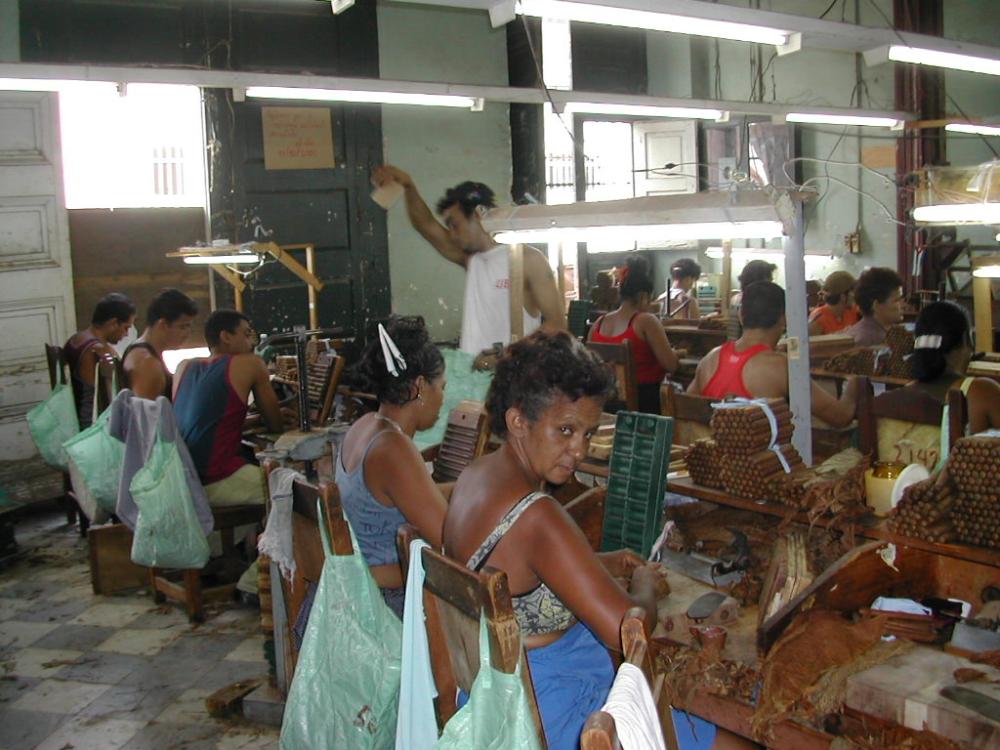
Cuba’s communist government collectivized agriculture and nationalized most property, including most workplaces. Above cigar workers in Trinidad, Cuba. Creative Commons. Photo by: James Emery (2009).
Reforms adopted since 1994 eased controls on distribution and private sales of goods (especially through use of the US dollar). Other reforms permitted the provision of specified private economic services. These expanded in 2008 and again in 2021 but the state still directs much of the economy.
The period since 1991 is described in more detail below, followed by Current Issues.
The “Special Period”
After the Soviet Union collapsed in 1991, Cuba lost an estimated $5 billion a year in economic subsidies. The country's gross national product fell by nearly half between 1989 and 1993. Cuba entered what Fidel Castro called a “special period” that required revolutionary mobilization and sacrifice. Students and workers were sent to plant and harvest crops. Goods were rationed further.
In 1994, the government adopted economic reforms to allow some foreign investment and a limited number of private economic activities. Joint ventures were formed by foreign companies with Cuban state entities possessing 51 percent ownership. Small, semi-private cooperative farms were able to sell surplus agricultural products on the market. Home-based private restaurants and hostels opened, as did special state-sponsored stores allowing purchases in US dollars, which could now be used as legal currency alongside the peso.
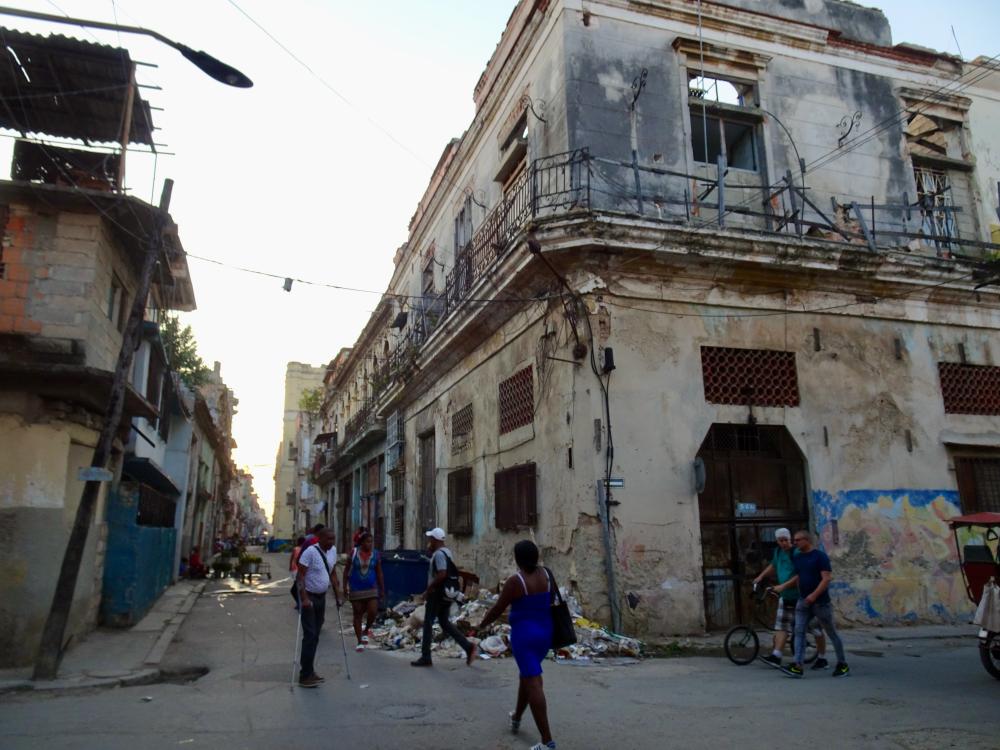
During the “Special Period,” when Cuba lost its subsidy from the Soviet Union, the economy went into free fall. Despite adoption of economic reforms, most Cubans have not seen improved conditions. While Old Havana is well maintained for tourism, most live in slums of unrepaired housing, as above. Creative Commons. Photo by: Bruno Rijsman (2023).
In 1994, US President Bill Clinton allowed family remittances and travel to the island. However, after the Cuban military shot down two civilian airplanes operated by an exile group to aid Cuban migrants at sea, the US Congress extended the economic embargo to penalize foreign firms doing business in Cuba. Specified trade in agriculture and medicine was allowed.
Resilience of the Regime
Some predicted the fall of the Castro government after the Soviet Union's collapse but it proved resilient. Since the limited reforms of the 1990s, the economy has depended in large part on growth of the tourist industry. This is financed mostly by European and Canadian investment but controlled by joint ventures connected to the Cuban military and security ministries.
Since the early 2000s, Venezuela's presidents Hugo Chavez and Nicolas Maduro provided a substitute energy subsidy. Their governments bartered oil in exchange for services of Cuban security and intelligence officers as well as medical personnel and teachers sent to Venezuela. Overall, prior to his death in 2013, Chavez provided an estimated $14 billion in loans, investment and grants. Under Maduro, the subsidies declined as the Venezuelan economy collapsed. Even so, Cuba continues to provide security personnel to aid in the Maduro government’s repression (see also Venezuela Country Study).
Leadership “Transition”
Fidel Castro ruled Cuba for 47 years uniting the positions as head of the Communist Party, President of the Council of State and head of the Council of Ministers. In July 2006, Castro, nearing 80 years old, temporarily transferred presidential powers to his brother Raúl, the Minister of Defense, before undergoing intestinal surgery. The elder Castro permanently resigned in February 2008, making Raúl ’s titles as President of the Council of State and of the Council of Ministers more permanent. Fidel Castro remained as First Secretary of the Communist Party of Cuba (PCC) until Raúl assumed this post in 2011.
In February 2013, the National Assembly, made up only of Communist Party-approved members, rubber-stamped Raúl Castro’s election to a second term as president. He continued to serve also as Commander in Chief of the Armed Forces and PCC First Secretary. Announcing it to be his last term as state president, Raúl, now 81 years old, selected a younger First Vice President, Miguel Díaz-Canel, to be his successor. He had headed the Young Communist League and served as minister for higher education (see also Current Issues).
Limited Economic Reforms
In 2008, the regime expanded the specified areas for private economic activity but most activities were restricted for use only in convertible pesos. These are available only by exchange in foreign currency and are 25 times the value of ordinary pesos earned as state wages by most workers. In 2011, the regime again extended the number of allowable economic activities (from 178 to 201) and the possibility to earn income privately and hire non-relative employees. It also announced limited possibilities to travel without an exit visa and to buy and sell homes and cars as property.
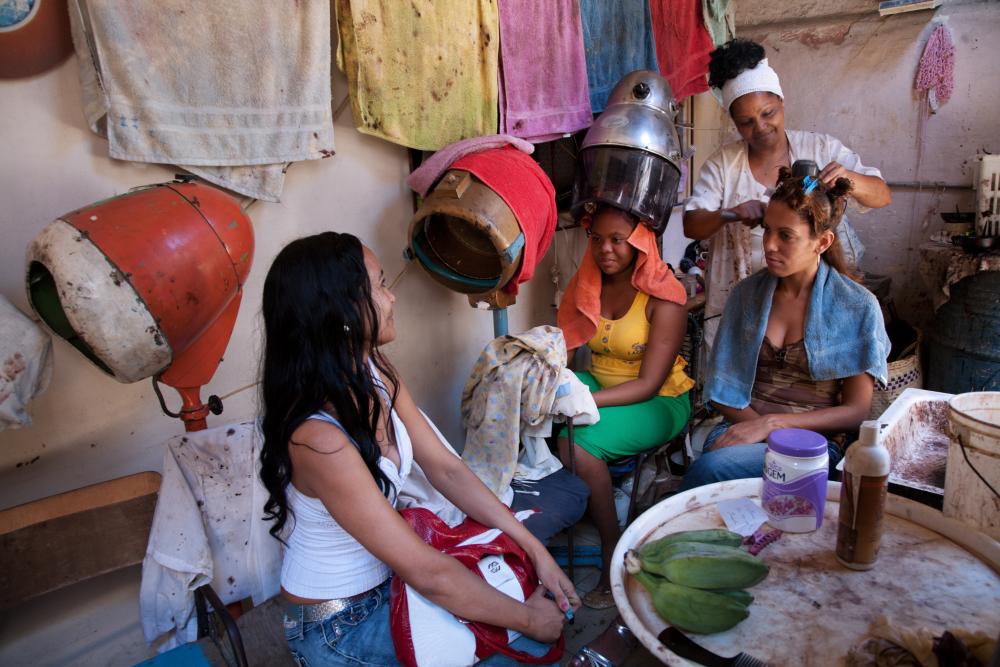
In 2008 and 2011, the regime expanded the specified areas for private economic activity, among them beauty salons, as shown above in 2011. But most activities were restricted for use only in convertible pesos. Creative Commons. Photo by: Jorge Ryan.
Still, the government must approve all professional licenses and property sales. Such approval is routinely denied dissidents or those deemed “enemies of the state.” State security harassment of entrepreneurs is common. The state still controls fully two-thirds of the economy.
In practice, reforms benefitted mostly Communist Party and state officials, who are more likely to own goods and property. Access to state housing, jobs or other privileges generally depends on political loyalty or serving as an informant to the police. Benefits of reform have largely bypassed Afro-Cubans.
Resistance and Repression
Cuban dissidents were encouraged by the fall of communism in the Soviet Bloc and acted to revive civic resistance in the mid-1990s. They organized independent human rights organizations, libraries, self-employment centers, trade unions and political groups. Musicians and artists organized alternative culture.
In 1997, four dissident leaders issued a declaration, "The Homeland Is for All," to demand human rights and democracy. The four were arrested and sentenced to prison, but the declaration, which was modeled on Eastern European dissident action, gained wide distribution and sparked bolder action. In 2002, Osvaldo Payá, the head of the dissident Christian National Movement, launched the Varela Project to petition for democratic changes to the constitution by referendum. The petition met the specified 10,000-signature requirement but was refused. Instead, the government organized its own controlled referendum to declare Cuba's socialist system "inviolable."
The regime cracked down on the growing independent activity. In 2003, in just one night, more than 100 activists and journalists were arrested. Seventy-five were sentenced to long-term imprisonment. In 2012, Payá, who had not been among those arrested, died with a colleague in a suspicious car crash.

Despite repression, including the arrest in one night of 75 dissidents in 2003, civic activity persists. Ladies in White was formed the same year by mothers, wives and daughters of political prisoners. They organized weekly protests, as above in 2012. They are often broken up by regime-sponsored vigilantes. Creative Commons. Photo by Hvd69.
Despite this repression, civic activity persisted. Most notably, a group called Damas en Blancos (Ladies in White) was formed in 2003 by mothers, wives and daughters of political prisoners. Ever since, Ladies in White has organized weekly demonstrations demanding release of all political prisoners despite repeated attacks by police and police-sponsored gangs.
Independent journalists have tried to break free of the government's control of media by using new technology. A movement of bloggers led by journalist Yoanni Sánchez emerged to report on daily life in Cuba (see Resources). The web pages were blocked, but reached Cubans with access to satellite Wi-Fi. At the same time, repression was constant. The Cuban Commission for Human Rights reported a record number of 9,000 detentions in 2014 and also the next year. Hundreds were detained prior to Pope Francis’s trip to Cuba in 2015.
Normalization Brings Little Change
In December 2014, US President Obama announced resumption of diplomatic relations with Cuba. The stated aim was to encourage more economic and political reforms. There was an exchange of Americans and Cubans held in prisons and the release of fifty-three high-profile Cuban political prisoners. President Obama called on Congress to end the trade embargo arguing that it had not resulted in desired changes in the regime. But leading members of Congress from both parties continued their support for the embargo as pressure to improve human rights.
Embassies were reopened in 2015 and President Obama made an historic trip to Cuba in March 2016 (the first US president to do so since 1924). Obama met both formally and informally with Raúl Castro but, unlike other foreign leaders, he also met with a group of dissidents. In a televised public speech, Obama specifically called for the Cuban government to end repression of political rights. Neither the trip nor the appeal significantly altered the state’s behavior. According to Human Rights Watch, arrests continued at a high rate in the years following the trip.
Current Issues
In November 2016, Fidel Castro died at the age of 90. Seen as a revolutionary and anti-American nationalist hero by some, his dictatorial rule resulted in mass repression, largescale exodus and generalized poverty. His brother, Minister of Defense Raúl Castro, had assumed the positions of head of state and First Secretary of the Communist Party of Cuba (PCC) in 2006 and 2011, respectively. He continued to rule Cuba as a police state.
In 2019, an amended constitution was adopted with slight changes to governing structures. Private ownership of property was now formally allowed but “under party-state direction.” The constitution still enshrined the Communist Party as “the organized vanguard of the Cuban nation” and the “superior driving force of the society and the State.”

Raul Castro was replaced as president of the Council of State in 2019 by his designated replacement, vice president Miguel Díaz Canal, shown above in 2015. There has been no significant political or economic change. Creative Commons Public Domain Declaration.
Also in 2019, Miguel Díaz-Canel, the minister of higher education, was elected president of the Council of State by the National Assembly as Raúl Castro’s designated replacement. Díaz-Canel named Tourism Minister Manuel Marrero Cruz as prime minister, a post restored under the new constitution to direct the government. In April 2021, Díaz-Canel was made First Secretary of the Communist Party of Cuba (PCC) to complete the formal transition of power.
None of these leadership changes brought real political or economic change. The 2023 elections to the National Assembly, now 470 members, still had only PCC-controlled candidates. No other political parties were allowed. Economic reforms remain limited with two-thirds of the economy fully under full state control and independent economic activity also under party-state direction. Police frequently seize assets and shut down private ventures of dissidents and civic organizations. A new penal code criminalizes receipt of foreign financing and increases minimum penalties for politically-related offenses.
The penal code changes were made in response to the largest opposition rally in 20 years. These occurred on July 11, 2021 to protest shortages of goods, economic deprivation and lack of freedoms. Miguel Díaz-Canel ordered deadly force to disperse demonstrators in various cities. Thirteen hundred persons were arrested. By the end of 2022, more than one thousand “J-11” demonstrators were sentenced to harsh prison terms.
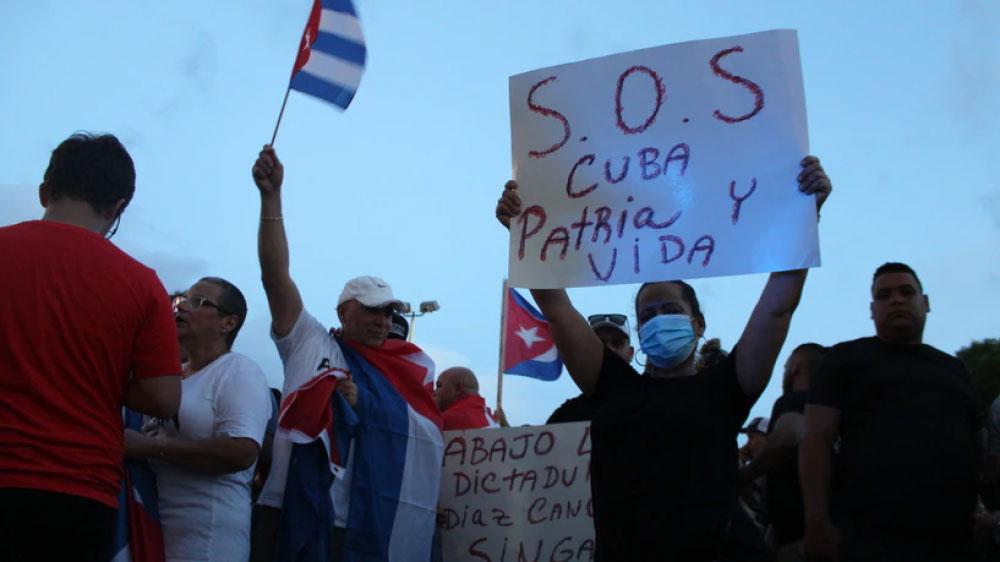
The July 11 protests in 2021 adopted the slogan “Patria y Vida” (The Homeland and Life), which counters the regime slogan of “Patria o Muerte” (The Homeland or Death). More than one thousand “J-11” demonstrators were sentenced to harsh prison terms. Public Domain. Voice of America. Photo by: Luis F. Rojas.
Previously, in April 2021, Luis Manuel Otero Alcántara, a leader of a dissident artists’ collective called the San Isidro Movement (MSI), had been arrested for holding a hunger strike to protest police destruction of the movement’s artwork. In June 2022, he and MSI co-founder Maykel Castillo Pérez were sentenced to nine and five years’ imprisonment, respectively. Other civic and activist groups are targeted, such as the 27N artist collectives, The Archipélago and the Patriotic Union of Cuba. Berta Soler Fernández, leader of the Ladies in White (see above), and Guillermo Fariñas, head of the United Anti-Totalitarian Forum (FANTU), were subject to repeated arrests in 2022.
The National Assembly signaled that repression would continue. In May 2023, it adopted a new "social communication law" that further limits speech and media freedom by instituting vague regulations regarding online content.
While reforms allow a limited right to private property, poverty remains high and is severe for marginalized communities such as Afro-Cubans. Following the reduction of Venezuelan subsidies and the Covid-19 pandemic, the economy worsened with high inflation, food shortages and power cuts. Poor economic conditions and high levels of repression have led to more than 250,000 people fleeing the island in the last three years.
The content on this page was last updated on .
